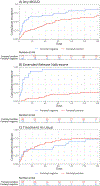Associations between fentanyl use and initiation, persistence, and retention on medications for opioid use disorder among people living with uncontrolled HIV disease
- PMID: 34600253
- PMCID: PMC8595584
- DOI: 10.1016/j.drugalcdep.2021.109077
Associations between fentanyl use and initiation, persistence, and retention on medications for opioid use disorder among people living with uncontrolled HIV disease
Abstract
Background: Associations between fentanyl use and initiation and retention on medications for opioid use disorder (MOUD) are poorly understood.
Methods: Data were from a multisite clinical trial comparing extended-release naltrexone (XR-NTX) with treatment as usual (TAU; buprenorphine or methadone) to achieve HIV viral suppression among people with OUD and uncontrolled HIV disease. The exposure of interest was fentanyl use, as measured by urine drug screening. Outcomes were time to MOUD initiation, defined as date of first injection of XR-NTX, buprenorphine prescription, or methadone administration; MOUD persistence, the total number of injections, prescriptions, or administrations received over 24 weeks; and MOUD retention, having an injection, prescription, or administration during weeks 20-24.
Results: Participants (N = 111) averaged 47 years old and 62% were male. Just over half (57%) were Black and 13% were Hispanic. Sixty-four percent of participants tested positive for fentanyl at baseline. Participants with baseline fentanyl positivity were 11 times less likely to initiate XR-NTX than those negative for fentanyl (aHR = 0.09, 95% CI 0.03-0.24, p < .001), but there was no evidence that fentanyl use impacted the likelihood of TAU initiation (aHR = 1.50, 0.67-3.36, p = .323). Baseline fentanyl use was not associated with persistence or retention on any MOUD.
Conclusions: Fentanyl use was a substantial barrier to XR-NTX initiation for the treatment of OUD in persons with uncontrolled HIV infection. There was no evidence that fentanyl use impacted partial/full agonist initiation and, once initiated, retention on any MOUD.
Keywords: Buprenorphine; Extended-release naltrexone; Fentanyl; HIV; Medications for opioid use disorder; Opioid use disorder.
Copyright © 2021 Elsevier B.V. All rights reserved.
Figures
References
-
- Ahmad FB, Rossen LM, Sutton P, 2020. Provisional drug overdose death counts. National Center for Health Statistics.
-
- Ahmed S, Bhivandkar S, Lonergan BB, Suzuki J, 2020. Microinduction of Buprenorphine/Naloxone: A Review of the Literature. Am J Addict. - PubMed
-
- Altice FL, Bruce RD, Lucas GM, Lum PJ, Korthuis PT, Flanigan TP, Cunningham CO, Sullivan LE, Vergara-Rodriguez P, Fiellin DA, Cajina A, Botsko M, Nandi V, Gourevitch MN, Finkelstein R, 2011. HIV treatment outcomes among HIV-infected, opioid-dependent patients receiving buprenorphine/naloxone treatment within HIV clinical care settings: results from a multisite study. J Acquir Immune Defic Syndr 56 Suppl 1(Suppl 1), S22–32. - PMC - PubMed
-
- Bisaga A, 2019. What should clinicians do as fentanyl replaces heroin? Addiction 114(5), 782–783. - PubMed
Publication types
MeSH terms
Substances
Grants and funding
LinkOut - more resources
Full Text Sources
Medical


